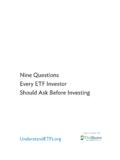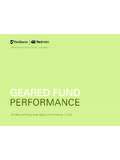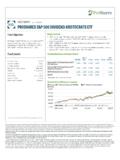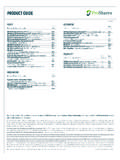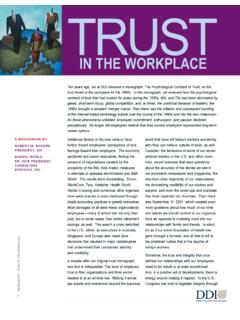Transcription of Alternative Investments Guide - ProShares ETFs
1 Alternative Investments Understanding their role in a portfolio2 While opinions vary on exactly what makes an investment Alternative , there is broad consensus that investors should be aware of alternatives and the potential benefits they can provide. Alternatives history of adding diversification, potentially enhancing return and improving the risk profile of a portfolio, has sparked interest in learning what these Investments can do under different market conditions and within a variety of asset allocation this Guide , we ll take a closer look at what alternatives are and why they may be appropriate in investor portfolios. But first, let s understand the fundamental reasons investors should be aware of alternatives and what they can ARE Alternative Investments ?What role can they play in today s approach to portfolio planning and asset allocation?1 WHAT IS A NORMAL MARKET?
2 Ask most people what they expect the stock market to return, and they may tell you around 9%. And over time, returns have averaged around that level. But the ride has not been a smooth one. Markets have gone up and down. And as we all learned the hard way in recent years when markets go down, the fall can be investors are hanging on to the belief that, if they can stick with the market long enough, they can capture the returns they ve grown to expect. But how long is long enough?Others hang back, afraid to get into the market because of the losses that burned them in recent what should we expect from the market a relatively smooth ride or a rocky one?Tug-of-war: volatility vs. returns05001,0001,5002,0002,5003,0003,50 04,0004,5001974 1978 1982 1985 198919921996200320072010201420172000 Annualized price return: price returns for S&P 500 1974 201720%20%40%60%80%100%85% 81% 1900191319261939195219651978199120042017 DOW JONES INDUSTRIAL AVERAGE 1900 1957S&P 500 1958 201791% 91% The bigger picture: Market storms come in cyclesThe weather offers a good analogy.
3 In Miami, for example, the average temperature is a very pleasant 76 degrees, and the sun shines 249 days a year. But don t forget that Miami gets hit by a hurricane about every four years and a major hurricane about every 10 years. If you lived in Miami, you wouldn t build your house just for sunny weather, would you?Like the weather, markets go through pleasant and unpleasant periods bull and bear markets and periods of high and low volatility. We know storms will come; we just don t know when they will means you may want to ensure your investment portfolio is properly FOR MARKET STORMSI nvestors should be prepared for both smooth and bumpy rides. If you look at the bigger picture over 100 years of history for the stock market you can see that the type of volatility experienced during the 2000s is not unprecedented. The 1910s, 30s and even the 80s also had periods of high volatility for DJIA and S&P 500 1900 2017 Like building a house to withstand a hurricane, preparing a portfolio to weathermarket storms is a critical step toward meeting long-term investment 1 Year 2 Year 3 6% 6% 6% 30% -20% 8% Simple Average ReturnCumulative ReturnAnnualized 6% 6% 6% 4% It s not always 76 degrees in Miami, and portfolios don t always return 9% per year.
4 There are good years and bad years, and the timing and magnitude of the good and bad years make all the difference. The volatility of portfolio returns can have a meaningful impact on the outcome for an the hypothetical example shown below. Investor A receives a 6% return each year for three years. Investor B receives a big gain in the first year, followed by a big loss in the second year, then another gain in the third portfolio would you prefer?Investor B may think his gains in years one and three more than made up for his loss in year two, and that his portfolio performed just as well as Investor A s. Simple averages support that hypothesis both investors have an average return of 6% over the three-year period, as can be seen in the chart. But investment returns don t average; they compound. It takes a much bigger gain or a longer period of gains to recover from a big loss.
5 On a cumulative basis, Investor A has a return of , or 6% annualized, while Investor B has a cumulative return of only , or 4% annualized one-third less than Investor A s course, these portfolios aren t real, but if you understand the mathematical concepts presented here, you can see the potential benefits of a smoother ride. One way to help smooth out returns is through diversification. The objective is to have something in your portfolio that is doing well at any given time, in any kind of in mind, all Investments have risk, and diversification may not protect you against losses in your portfolio. But your chances of having a smoother ride are probably better if your portfolio is A s smoother ride led to a better return A BETTER PATHThis is an illustration and is not meant to represent the performance of a particular AInvestor B4 TRUE DIVERSIFICATION? CORRELATION TELLS THE STORYFor decades, investors have used a range of traditional asset classes to diversify their portfolios: domestic stocks, international stocks, emerging market stocks, and bonds.
6 But how much diversification do these asset classes really provide? The concept of correlation sheds some light on a statistical measure of how two variables relate to one another is a way to measure the diversifying effect of an investment when added to a portfolio. Two different Investments with a correlation of will move in exact lockstep, Investments with a correlation of zero will not move at all in relation to each other, and Investments with a correlation of will move in opposite higher the correlation, the lower the diversifying effect; the lower the correlation, the greater the diversifying effect. In other words, to get a smoother ride, you need to combine assets that don t all move in the same direction, to the same degree and at the same D(Negative) B(High)Asset C(Low)Lower correlation: Better diversificationFor illustrative purposes only. For example, if you were looking for a diversifier for Asset A in your portfolio, Asset C and Asset D would be much better choices than Asset many years, combining a variety of equity asset classes with varying correlations to the S&P 500, along with a healthy dose of bonds, did a good job of providing enough diversification for investors didn t anticipate is that during periods of market distress, the correlations of these traditional diversifiers would increase sometimes significantly.
7 But that s exactly what happened. During the down markets of the last two decades, not only did these traditional asset classes move in the same direction, they moved more closely together. In other words, their diversifying effects broke down just when they were needed most. Time and broader trends have also led to a rise in correlations. Take international stocks. With globalization, correlations to the S&P 500 went from in the 1980s to in the 1990s to in the early , bonds have continued to provide diversification, especially during stressful times. However, in today s environment of historically low interest rates, there s no guarantee bonds will continue to beeffective DIFFERENT MARKETS, CORRELATION CHANGES Correlation to S&P 500 Large-Cap Stocks(S&P 500)Small-Cap Stocks(Russell 2000)International Stocks(MSCI EAFE)Emerging Markets Stocks(MSCI Emerging Markets) Bonds(Bloomberg Barclays Agg.)
8 Rose in down markets (1989-2017)OverallDown Markets6 CONSIDER Alternative INVESTMENTSA lternative Investments may be part of the solution. Alternatives can refer to asset classes or strategies. Generally speaking, they are Investments outside long-only positions in the traditional asset classes of stocks, bonds and cash. Many alternatives have a low correlation to traditional assets, although that s not always the asset classes include a variety of real, hard and financial assets. Real, hard assets are tangible items that hold inherent value like real estate, commodities, precious metals and collectibles. These asset classes are often used for inflation protection. Financial assets are intangible and include Investments like currencies, volatility and private equity. Alternative strategies are Investments that employ investment techniques or processes that are not in the mainstream and are therefore considered Alternative .
9 Many Alternative strategies use leverage or short selling in their efforts to generate returns. For example, a hedge fund may use long and short positions in equities or fixed income, while a managed futures fund may combine long and short positions in commodities and currencies. Alternative asset classes and strategies historically may have been relatively difficult to access for the majority of investors, in some cases because of large investment minimums and long lock-up periods for capital invested. They also may have been less liquid or difficult to value other factors that have made them Alternative . But with new products increasingly available, many of these barriers are starting to fall Alternative Investments can be used for diversification, seeking to enhance returns and manage risk in a portfolio, they have their own risks that need to be considered when investing.
10 For example, commodity prices are highly volatile, and investors may experience significant losses in a short period of time. Investments such as futures are subject to a high degree of fluctuation and should be considered speculative. And short positions could lose significant value if security prices rise. That said, what makes alternatives attractive is that their risks are different from those of traditional asset asset classes include a wide variety of investment types that provide exposure to real, hard or financial strategies tend to useunconventional approaches (like leverage and short selling). Alternative Asset ClassesAlternative StrategiesALTERNATIVE Investments Real estate Commodities Precious metals Currencies Volatility Private equity Infrastructure Geared investing - Leveraged investing - Inverse investing Long/short strategies Market neutral Absolute return Convertible/merger arbitrage Managed futures Global macro8 For a portfolio of conventional Investments with a high correlation tothe stock market, adding alternatives allows more possibilities to diversify when seeking to enhance return and manage risk in a THE CONVENTIONALThe chart on the following page shows a wide range of traditional and Alternative asset classes and strategies with their correlations to large-cap stocks, as represented by the S&P 500.
